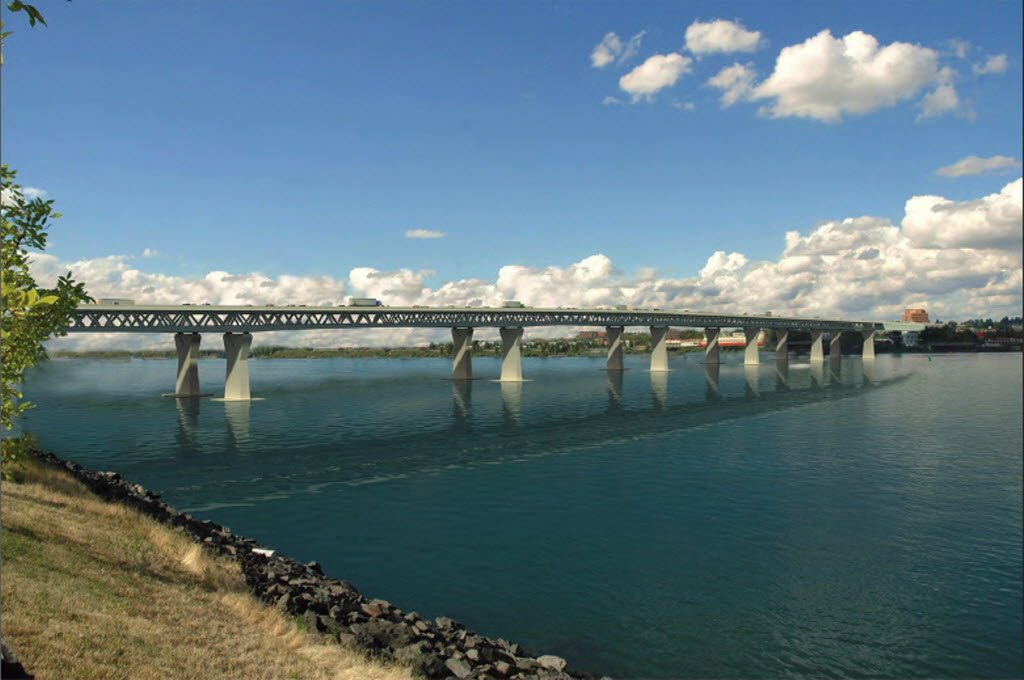Following an update on financial plans for the Columbia River Crossing Thursday, its director, Nancy Boyd, said that estimates that construction will start in 2013 are “optimistic.”
The project, projected to cost $3.1 billion to $3.5 billion, relies on funding from local tolls, Oregon and Washington and the federal government — and it’s not likely all those pieces will fall together by then, staff reports to the CRC’s Project Sponsors Council predicted.
The news came to the council — a bistate panel that advises the governors on the project — less than a week after federal approval came through, giving planners the authority to lobby for federal money to pay for the controversial highway and transit project.
Oregon and Washington will need tax and fee hikes to come up with the $450 million each is expected contribute to construction. While Gov. Chris Gregoire is expected to pitch a statewide
transportation package to lawmakers next month, with a possible vote in November 2012, Oregon is not nearly as close to that point.
The Oregon Legislature’s awareness of the project isn’t as high, co-chair Henry Hewitt told the group at the Washington State Department of Transportation regional office in northeast Vancouver. The part-time legislature is also only holding a 35-day short session in 2012, which won’t leave much time for complicated transportation talks.
“The overall level of understanding on the Oregon side is not significant,” Hewitt said.
Federal officials are still wrangling over a new national transportation package, which expired in 2009 and hasn’t yet been renewed, WDOT Federal Relations Manager Allison Dane Camden said. The House and Senate plans also differ, with the Senate bill currently containing money for “projects of national significance,” under which the CRC would fall, while the House bill isn’t as clear. While some hope a federal transportation act could pass next year, “I’m guessing 2013,” Dane Camden said.
Boyd and a spokeswoman for the CRC did not return an email Thursday asking if costs would continue to run about $1 million a month if the project overruns its anticipated timeline. Between 2004 and Sept. 30, the project has spent $136 million on planning.
But after the meeting, Boyd said that it’s important to have an optimistic starting date so that design plans are ready should money become available.
The project — which includes replacing the Interstate 5 Bridge, extending Portland’s light rail into downtown Vancouver, a bike and pedestrian deck and seven interchange improvements over five miles — will undoubtedly be finished in phases, staff said.
Each state will pay for the improvements within its borders and then split the cost of bridge construction, Washington DOT Director Paula Hammond said. But even if Washington antes up for the CRC faster than its southern neighbors, work must be done evenly on both sides. Otherwise, Hammond said, it would affect tolling — drivers won’t pay to use a corridor that isn’t improved.
Instead, while the goal is to finish construction as soon as possible, “how fast you can do that as far as cash flow” isn’t clear, Boyd said.
“It’s about marrying up the financing plan with construction,” Hewitt said.
Tolls, jobs
Local elected officials from Oregon and Washington also drilled staff about particular concerns for their jurisdictions.
Vancouver Mayor Tim Leavitt and Clark County Commissioner Steve Stuart asked about tolling and local construction jobs the CRC could generate.
Leavitt, who along with Stuart has been goading Congresswoman Jaime Herrera Beutler, R-Camas, to publicly support the plan and lobby for federal money, asked what would happen if more federal funding than expected came through.
Hammond, however, set that question down gently.
“It’s a problem we’d love to have,” she said. “But we’re challenged and working hard to get the money we need.”
Stuart then reiterated that the Southwest Washington Regional Transportation Council — one of the local signatories to the CRC’s final environmental plans — only agreed to the project if any budget shortfalls don’t equate to tolling increases.
“If there’s not enough money from the state and feds, don’t put it on the backs of tolls,” he said.
He also asked about the 1,900 jobs a year the project claims it will generate and if those figures could be broken down into specific types of jobs.
Staff said they can only estimate that is the total number of jobs the project will directly create, sustain (such as construction and planning work) or indirectly influence (such as food carts set up near the construction site to feed workers).
The commissioner then asked if stipulations could be made to require local hiring only.
“When you use federal money, you can’t do that,” Hammond said. “We have programs that will really work hard on developing and matching up small businesses to the kinds of prime contractors who would bid (on the project). It’s been very successful.”
Co-chair and Vancouver attorney Steve Horenstein also said there is only one regional contractor that would even qualify to serve as the primary firm on the Columbia River Crossing: “Others will come from lord knows where.”
Oregon Metro Councilor Rex Burkholder also asked about an improvement fund and mitigation for the construction ground-zero zone of Hayden Island, which his board was very concerned about. Staff responded that the Oregon Legislature will have to come up with any of that money.
The Project Sponsors Council hadn’t met since February, and Thursday’s gathering was its last, as members said the panel has now fulfilled its purpose. In its place, the CRC is holding Integrated Project Sponsors Council Staff meetings, which are comprised of staff members from the various agencies whose elected officials were on the Project Sponsors Council. Those meetings, however, are not public.



